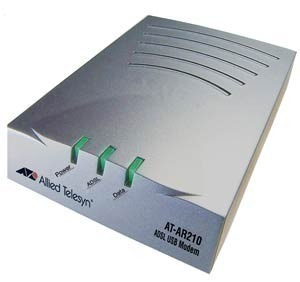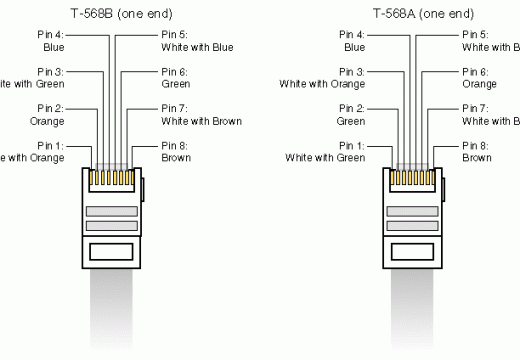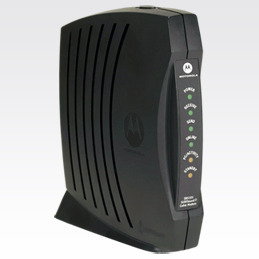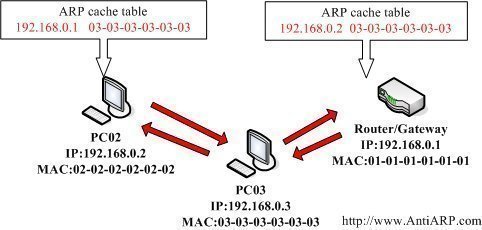Digital Subscriber Line or Digital Subscriber Loop (DSL) is a type of high-speed Internet technology that enables transmission of digital data via the wires of a telephone network. DSL does not interfere with the telephone line; the same line can be used for both Internet and regular telephone services. The download speed of DSL ranges between 384 Kbps and 20 Mbps. The most popular implementation of DSL today is Asymmetric Digital Subscriber Line (ADSL). It is asymmetric because the upload and download speeds are not the same (not synchronized). Upload is typically much slower than the download because it is usually not as needed as the high download speed.
One thing to note is that the distance in which the data has to travel does somewhat reduce the upload and download speed. Modern day ADSL can handle upward of 24 Mbits/s over a 2 kilometer stretch of wire. However, when the wire is made to be longer than 2 kilometers (or anything longer than 1.25 miles), the data transfer becomes diminished. It is because of this that, while the ADSL can have a great download rate, the farther the individual is from the service provider the less that they are likely to get. Therefore, the service providers tend to advertise the low ball, but a consumer might get more. It all depends on the distance the information has to travel across the copper wires.
DSL splits the frequencies used in a solitary phone-line into two main bands. The high-frequency band is used to send ISP data, and the low-frequency band is used to send voice data. Because of this technology, we are able to enjoy Internet access while using the telephone at the same time. DSL can be installed easily and work alongside any existing equipment for your standard phone line.
Regular DSL
Regular DSL is the standard form of DSL that requires an existing landline for data and voice to be transferred through. In regular DSL, customers generally bundle phone and Internet together and have access to both simultaneously. Voice signals are passed through the wires at a much lower frequency than data signals and thus allow for data to be transferred while not interfering with voice signals over the same line.
Naked DSL
In naked DSL, customers are not required to have an existing landline connected to have access to the Internet. This allows for customers to drop the extra fees associated with landline phones and switch primarily to their cell phone plan. There has been much controversy over naked DSL but inevitably, many telephone providers have been forced to offer it as part of their packaged plans.
DSL setup
DSL service needs a DSL modem (known as a DSL Transceiver) to be connected to the phone line or jack. The DSL modem then connects to the computer. On the telephone company’s end, the phone line is connected to a Digital Subscriber Line Access Multiplexer (DSLAM). DSLAM is basically a network apparatus that attaches multiple DSL lines to a high-speed Internet backbone.
The DSL modem, DSLAM, and the computer must be in sync with each other for the DSL service to work properly. The sync process is as follows:
- When the DSL modem is turned on, it goes through a self-test.
- The DSL modem then checks its connection with the computer via the Ethernet or USB port.
- The DSL modem then tries to sync with the DSLAM.
The sync process usually lasts a few seconds. DSL modems have a light indicator marked as DSL or LINK. If the sync process is successful, the green light will stay on.
DSL technologies
There have been many versions of DSL as it has been upgraded so many times over the years. The following is a full list of DSL versions and types that have become available to the public.
ISDN Digital Subscriber Line
ISDN Digital Subscriber Line was one of the first forms of DSL and used a technology known as ISDN to transfer signals.
High Data Rate Digital Subscriber Line
High Data Rate Digital Subscriber Line was the first DSL device that used twisted copper cables to transfer signals in a high frequency spectrum.
Symmetric Digital Subscriber Line
In Symmetric Digital Subscriber Line, equal amounts of data are uploaded and downloaded at any given time.
Symmetric High Speed Digital Subscriber Line
Symmetric High Speed Digital Subscriber Line was created to serve as a faster replacement for Symmetric Digital Subscriber Line.
Asymmetric Digital Subscriber Line
In Asymmetric Digital Subscriber Line, more information is downloaded than is uploaded at any given time.
Asymmetric Digital Subscriber Line 2
Asymmetric Digital Subscriber Line 2 provided quality that its predecessor lacked.
Asymmetric Digital Subscriber Line 2 Plus
Asymmetric Digital Subscriber Line 2 Plus increased the data transfer speeds of DSL by 200%.
Asymmetric Digital Subscriber Line Plus Plus
Asymmetric Digital Subscriber Line Plus Plus was created in Japan and increased the data transfer speeds of DSL to 50 megabits per second and increased the spectrum used to 3.75 megahertz.
Rate-Adaptive Digital Subscriber Line
Rate-Adaptive Digital Subscriber Line is used to decrease speed while increasing range and performance of the signal.
Very High Speed Digital Subscriber Line
Very High Speed Digital Subscriber Line was simply a faster version of previous models.
Very High Speed Digital Subscriber Line 2
Very High Speed Digital Subscriber Line 2 was invented to replace the already enhanced speeds of Very High Speed Digital Subscriber Line.
Etherloop
Etherloop is the technology that allows for Ethernet cable to be used in transmitting data and voice over a phone line.
Uni-DSL
Uni-DSL is a system introduced by Texas Instruments that works with all forms of DMT, which is the method in which frequencies are separated into high and low signals, allowing for data and voice to be transferred over the same wire at the same time.
Gigabit Digital Subscriber Line
Gigabit Digital Subscriber Line offers speeds never before seen before in the DSL community, capable of transferring data at roughly 128 mbps.
Universal High Bit Rate Digital Subscriber Line
Universal High Bit Rate Digital Subscriber Line is the newest version of DSL and is an example of fiber optic technology. Universal High Bit Rate Digital Subscriber Line offers extremely fast speeds and reliable service when installed properly.
ADSL (Asynchronous DSL)
ADSL (Asymmetric DSL) is a type of DSL where the upstream and downstream bandwidth are assigned different amounts of bandwidth. Typical configurations today are 2Mb downstream and 128Kb upstream.
Downstream refers to data which you are downloading across the network to your local systems. Upstream refers to data you are sending from your local systems across the network.
IDSL (ISDN over DSL)
IDSL (ISDN over DSL) is a 144Kb standard for DSL. IDSL is used when other types of DSL are not available. IDSL is slow and relatively expensive, but it can sometimes be the best possible option.
RADSL (Rate-adaptive DSL)
RADSL (Rate Adaptive DSL) is an asymmetric DSL variant which can adjust the speed of the DSL connection depending on the distance from the Central Office (CO) and the quality of the connection.
SDSL (Symmetric DSL)
SDSL (Single line DSL) is a DSL type where the upstream and downstream are both set to the same bandwidth. SDSL typically operates at 1.5Mbps upstream and downstream.
VDSL (Very high bit-rate DSL)
VDSL (Very high bit-rate DSL) is an asymmetric version of DSL which operates at very high speeds, but only at a distance of up to 1000 feet from the Central Office (CO).
DSL Lite
DSL Lite is an asymmetric variant of DSL which places the DSL splitter at the telco central office instead of in the customer premises.
G.SHDSL (Single-pair High-speed DSL)
G.SHDSL (Single-pair high-speed Digital Subscriber Line) is a variant of SDSL which is defined by ITU standard G.991. It works at symmetric speeds from 192Kbps-2304Kbps on a single line pair and 384Kbps-4608Kbps over two pairs.
Europeans refer to G.SHDSL as “SDSL”, causing confusion with existing SDSL equipment.
DSL Splitters
Most American homes have two pairs of wires from the local telephone company. If the home has only one telephone line in use, DSL can be installed on the second pair.
If the home has both telephone lines in use, DSL must share one wire pair with voice traffic. This is done using a DSL splitter.
A DSL splitter is a small box attached to the wire pair in order to split it into two separate wire pairs – one for voice traffic and the other one for DSL traffic.
For more information on telephone wiring, read How do I install telephone wiring?




Cornan
Given the number of forms of DSL mentioned I’m surprised to see that the (old definition) of Adaptive DSL, that adjusted the upstream and downstream rates based on traffic (not distance from the CO) wasn’t even mentioned.
I’m trying to do a little research on this form of DSL, which was (sadly) not adopted by the industry, creating headaches for IT professionals like myself that need a more equitable distribution of bandwidth.
Unfortunately, this inflexible emphasis on fixed upstream rates now extends to other technologies such as AT&T U-Verse, which has pitiful upstream rates.
Khassim
What causes up stream and down stream to drop on adsl modem to drop.
memenode
I’m not sure what you mean. If you are referring to the speed on ADSL being lower than advertised this is usually due to signal loss between you and the closest hub.
If you’re referring to intermittent slow-downs this can be due to various issues, from your own connection being overloaded, to the ISP network being overloaded, to deliberate throttling done by your ISP.
If you’re referring to a difference between upload speed and download speed, that’s down to the way ADSL works. ADSL = Asynchronous Digital Subscriber Line, meaning the up and down speeds aren’t the same, and I believe this is used to save on bandwidth and infrastructure costs, and because most people download far more than they upload.
ankur khanna
thank u
reader
ankur khanna